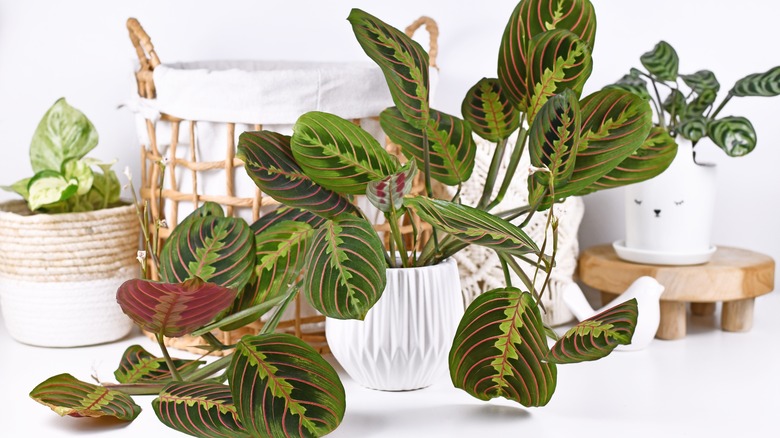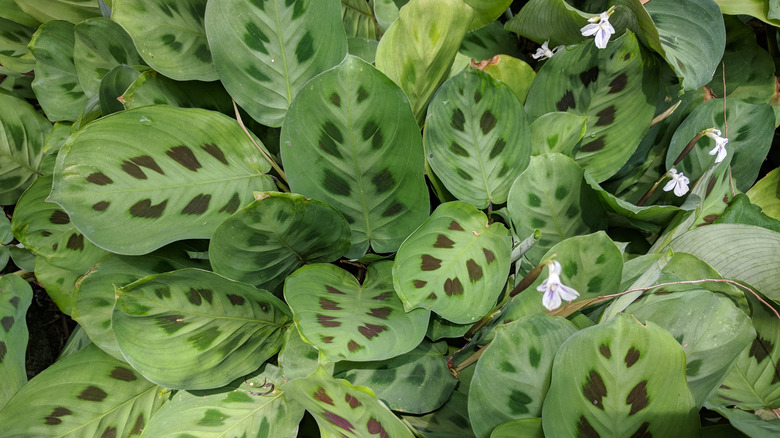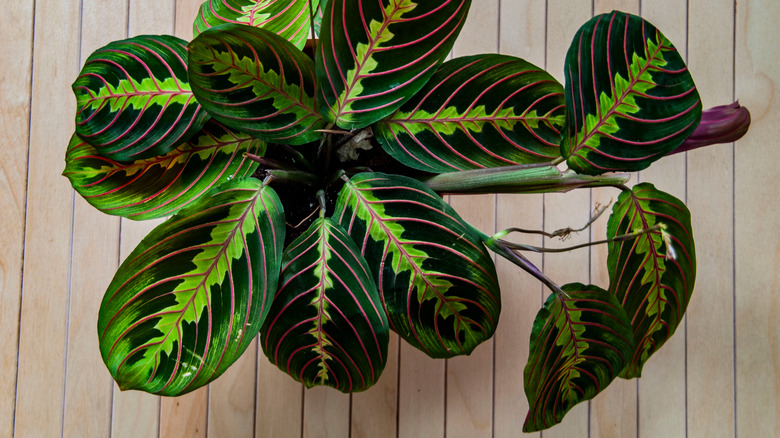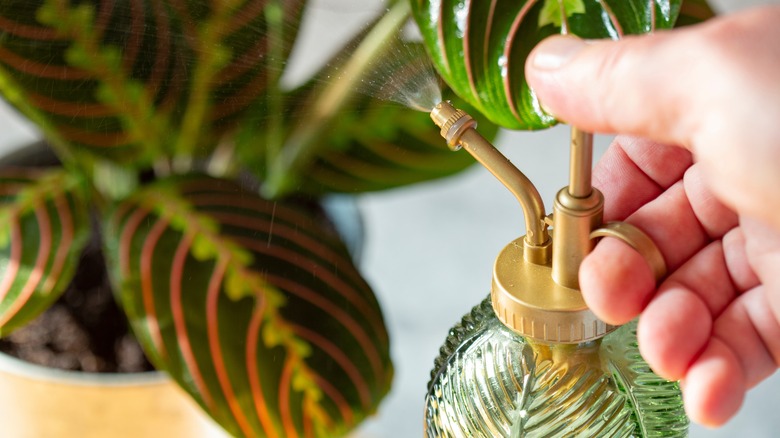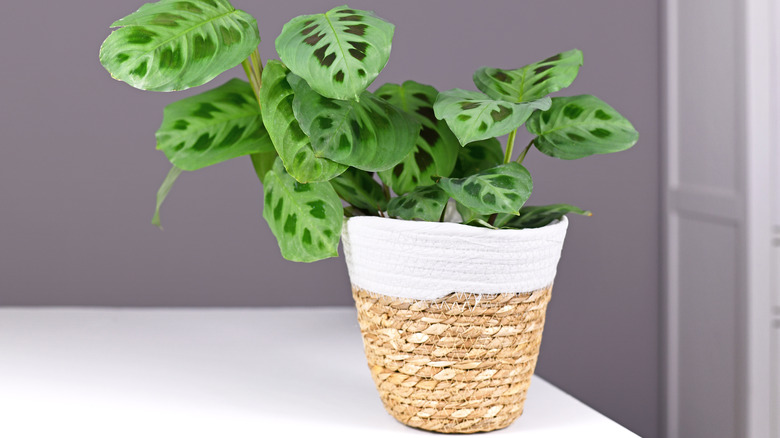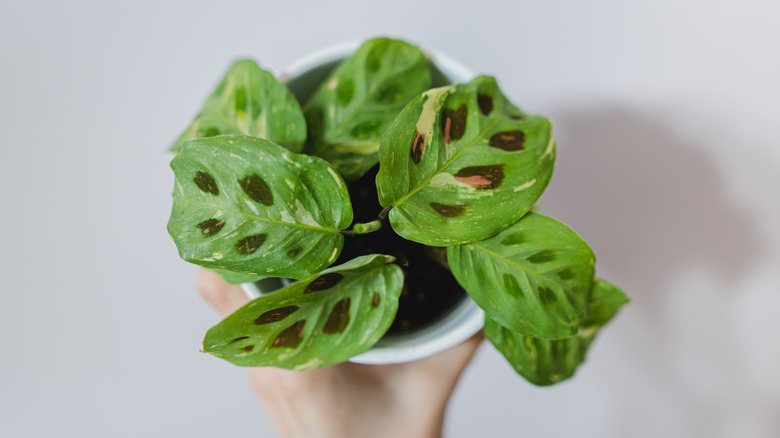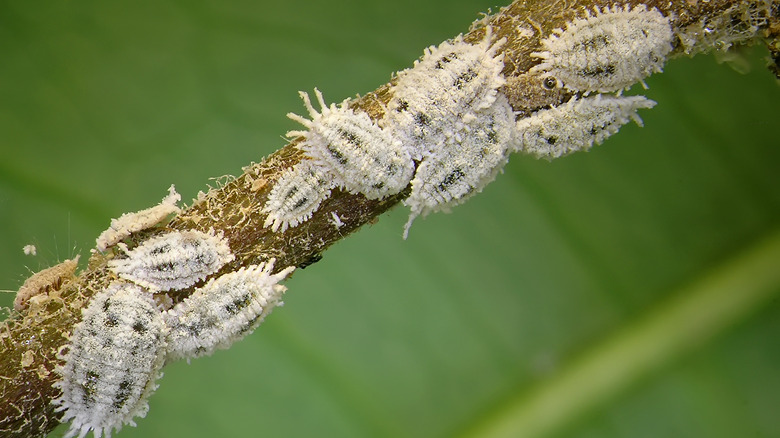How To Get The Most Out Of Your Prayer Plant
The prayer plant, also known by its scientific name maranta leuconeura, is native to the tropical forests of Brazil. It is technically a flowering rhizomatous perennial, however, it's unlikely that you will ever see it bloom when grown as a houseplant, according to The Spruce. Maranta leuconeura is known as the prayer plant because at night, it folds up its leaves like praying hands. During the day, its leaves fold back down into a flat position.
Prayer plants are characterized by their large oval leaves of dark and light green color with red veins. The plant can grow up to 1 foot tall, and each leaf will grow to about 5 inches long. Prayer plants are often kept as indoor houseplants in homes all over the world. If you are a beginner gardener, beware — prayer plants are not the easiest plant to keep alive. They require specific conditions, and they are susceptible to infestations as well as problems such as fungal infections and root rot.
How to use prayer plants in the garden
Prayer plants are not typically grown in the garden. Few U.S. states have the outdoor growing conditions for these plants to survive. Cold weather, too wet, or too dry conditions will kill a prayer plant fast. If you live in southern Florida, it's possible for you to grow a prayer plant in your garden, but you will likely be met with many problems and a quick death for your plant. Prayer plants are much happier when grown indoors under a watchful eye, as per Smart Garden Guide.
When prayer plants do grow outdoors, such as in the Brazilian tropical forests, they grow close to the ground. They may grow as tall and as wide as 1 foot. The plants also have small white flowers during their growing season. Other than Brazil, you may find maranta leuconeura outdoors in containers on top of gravesites. It is not uncommon to leave this plant for a loved one who has passed on to represent everlasting life and prayer.
How to grow prayer plants
Before growing prayer plants, you'll need to find rich, well-draining soil. Do not use regular plant potting mix when planting your maranta leuconeura, said Gardener's Path. All-purpose potting soil normally contains perlite, which has fluoride in it. Fluoride can lead to browning leaves and other problems. Instead, you should find a potting mix with coconut coir or peat moss.
When looking to grow prayer plants, you have two options: propagation or buying a young plant from your local nursery. If you are interested in the latter, see our repotting section for advice. You can propagate your prayer plant by division or cuttings. Division typically has better results. Gardening Know How tells us to do it in the early spring while repotting. While your prayer plant is out of its pot, gently spit it into two or more sections. Make sure your sections have at least four stems and plenty of healthy roots. Plant your divisions in small pots and carefully watch them for a few weeks until they show new growth. To propagate prayer plants through cuttings, begin by taking a stem of about 4 inches from your plant with sterile scissors. Place your cutting in a glass of water and watch for roots to grow. This could take several weeks. Once the cutting has a healthy root system, plant it in a pot with well-draining soil.
How to care for prayer plants
Taking care of a prayer plant is not the easiest task. They require specific light, humidity, and temperature conditions to thrive. According to The Spruce, they will die if they are subject to too cool or too dry conditions. You'll know that your prayer plant is unhappy in its environment when it begins to lose its leaves, develop brown spots, or become ill with a fungal infection. Your prayer plant needs indirect sunlight. Many maranta leuconeura can survive with no direct sunlight at all. Never place this plant near a sunny window; direct sunlight will damage its leaves, causing brown spots and burns. Additionally, make sure that the temperature near your prayer plant is always between 60 and 75 degrees Fahrenheit.
Prayer plants need humidity and need to be kept moist during their growing season, said Garden & Happy. If the air in your home is dry, you can make sure the area around your plant is humid enough by placing it near other plants, using a humidifier, or regularly spraying its leaves with warm water. Be sure to water the plant each time the top half-inch of soil dries out. When water drains out into its saucer, throw it out to combat root rot brought on from standing in excess water. Furthermore, prayer plants can benefit from fertilizing twice per month. Gardener's Path recommended using diluted, liquid houseplant fertilizer in the early spring to early fall.
Prayer plant varieties
Maranta leuconeura are not the only prayer plants. In fact, there are more than 40 species within the maranta genus that all use the common name "prayer plant" due to their nighttime prayer pose. All of these species hail from the tropical regions of central and south America, according to Gardener's Path. Even in the leuconeura species, there are varieties of prayer plants with different coloring and sizes. Here, we will go over some of them.
-
"Lemon Lime": This is characterized by yellow, light green, and dark green leaves. Like other variations, it spreads slowly and looks great in hanging baskets.
-
"Black Prayer Plant" or "Fascinator": With black and dark green leaves, this leuconeura variation is one of the largest prayer plants sporting a gothic appearance.
-
"Kerchoveana" or "Green Prayer Plant: The variation is also referred to as rabbit tracks or rabbit's foot due to small dark prints on its leaves that look like a rabbit may have stepped on them.
-
"Erythroneura" or "Red Prayer Plant": This plant type has red veins and three shades of green on its leaves. It is also called the herringbone plant.
-
"Massangeana": The plant features green-blue leaves, pink-sliver patches along its midline, and white veins.
How to repot a prayer plant
Maranta leuconeura does not need to be repotted often. Normally, you can get away with repotting them only when they've become rootbound, or roots are coming out of the pot's draining hole. To repot a prayer plant, you will need rich, well-draining soil and a pot with a draining hole. If you are also dividing your prayer plant while repotting, you will need one or more shallow pots for the divisions. Smart Garden Guide said you may start this process by taking your prayer plant out of its original container. Try running a flat tool, such as a butter knife, along where the soil meets the pot if you are having trouble with this step.
Once your prayer plant is out of its old pot, gently tease the old soil out of its roots and give it a light shake. Transplant it to a new pot that is 1 or 2 inches larger in diameter. Pack the new soil on top of its roots and generously water the prayer plant until water runs out into the saucer.
Prayer plant's common pests and diseases
Prayer plants are often victims of several different types of pests and diseases. They are commonly infested with mealybugs, scale, and spider mites. Mealybugs can look like little white pieces of dust on your plant. You can remove them with rubbing alcohol or by spraying neem oil, as per Gardener's Path. Scale is similar to mealybugs and can be removed the same way. They are round with light brown and dark brown stripes or spots. Spider mites can be more difficult to spot. Some telltale signs of them are yellow dots on your plant's leaves, small webs, or gray dust. Spider mites can also be killed with rubbing alcohol or neem oil.
Leaf spot, also known as helminthosporium, is a common infection contracted by prayer plants, according to Smart Garden Guide. You can identify it by small yellow spots on your plant's leaves. It is caused by overwatering and can be corrected with a new watering routine. This disease can be deadly to prayer plants. The best way to avoid it is to learn how to water your plant properly and ensure that it never stands in water. Cucumber mosaic virus, which is also referred to as leaf spot, is another deadly disease. It can be diagnosed by noticing yellow line patterns on your plant's leaves. Unfortunately, there is nothing that you can do to fix it.
